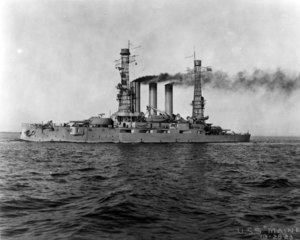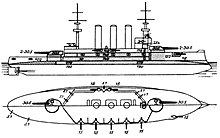USS Maine (BB-10)
 USS Maine underway in 1918
| |
| History | |
|---|---|
| Name | Maine |
| Namesake | State of Maine |
| Builder | William Cramp & Sons |
| Laid down | 15 February 1899 |
| Launched | 27 July 1901 |
| Commissioned | 29 December 1902 |
| Decommissioned | 15 May 1920 |
| Fate | Broken up, 1922 |
| General characteristics | |
| Class and type | Maine-class battleship |
| Displacement |
|
| Length | 393 ft 10 in (120.04 m) |
| Beam | 72 ft 3 in (22.02 m) |
| Draft | 24 ft 4 in (7.42 m) |
| Installed power |
|
| Propulsion |
|
| Speed | 18 kn (21 mph; 33 km/h) |
| Complement | 561 officers and enlisted |
| Armament |
|
| Armor |
|
USS Maine (BB-10), the lead ship of her class of pre-dreadnought battleships, was the second ship of the United States Navy to be named in honor of the 23rd state. Maine was laid down in February 1899 at the William Cramp & Sons shipyard in Philadelphia. She was launched in July 1901 and commissioned into the fleet in December 1902. She was armed with a main battery of four 12-inch (305 mm) guns and could steam at a top speed of 18 knots (33 km/h; 21 mph).
Maine served in the Atlantic for the entirety of her career with the North Atlantic Fleet, which later became the Atlantic Fleet; during the early years of her service, she was the fleet flagship, until she was replaced in 1907. Later that year, she joined the cruise of the Great White Fleet, though her heavy coal consumption prevented her from continuing with the fleet past San Francisco. After returning to the U.S., she served as the 3rd Squadron flagship. During America's participation in World War I from April 1917 to November 1918, Maine was used as a training ship. She remained in active service until May 1920, when she was decommissioned. The ship was ultimately sold for scrap in January 1922 and broken up for scrap under the terms of the Washington Naval Treaty signed that year.
Description
The

Maine was 393 feet 11 inches (120.07 m)
The ship was armed with a
Maine's main
Service history
Maine was built by the
Maine's next significant action was the cruise of the
Maine and Alabama crossed the Pacific independently, via Guam and the Philippines. After steaming through the Indian Ocean, they transited the Suez Canal and cruised the Mediterranean. They crossed the Atlantic and arrived back on the east coast of the United States in October 1908, well ahead of the rest of the Great White Fleet. Following their arrival, Maine was assigned as the flagship of the 3rd Squadron, Atlantic Fleet, and operated off the east coast for the next several months.[3] On 14 February, Maine, the new battleships New Hampshire, Mississippi, and Idaho, two armored cruisers and two scout cruisers were organized to meet the returning Great White Fleet. Maine and the rest of the squadron, under the command of Rear Admiral Conway Hillyer Arnold, steamed out into the Atlantic and rendezvoused with the Great White Fleet on 17 February. The combined fleet arrived in Hampton Roads on the 22nd, where a large naval review was held for Theodore Roosevelt to celebrate the journey.[8] On 31 August 1909, the ship was temporarily decommissioned at Portsmouth, New Hampshire. She returned to service on 15 June 1911 for duty with the Atlantic Fleet.[3]
On 6 April 1917, the United States declared war on Germany, entering
Footnotes
Notes
Citations
References
- Albertson, Mark (2007). U.S.S. Connecticut: Constitution State Battleship. Mustang: ISBN 978-1-59886-739-8.
- Albertson, Mark (2008). They'll Have to Follow You!: The Triumph of the Great White Fleet. Mustang: Tate Publishing. ISBN 978-1-60462-145-7.
- Campbell, N. J. M. (1979). "United States of America". In Chesneau, Roger & Kolesnik, Eugene M. (eds.). Conway's All the World's Fighting Ships 1860–1905. Greenwich: Conway Maritime Press. pp. 114–169. ISBN 978-0-85177-133-5.
- Friedman, Norman (1985). U.S. Battleships: An Illustrated Design History. Annapolis: ISBN 978-0-87021-715-9.
- Hendrix, Henry (2009). Theodore Roosevelt's Naval Diplomacy: The U.S. Navy and the Birth of the American Century. Annapolis: Naval Institute Press. ISBN 978-1-61251-831-2.
- Jones, Jerry W. (1998). U.S. Battleship Operations in World War I. Annapolis: Naval Institute Press. ISBN 978-1-55750-411-1.
- "Maine (Battleship No. 10) ii". Naval History & Heritage Command. 29 January 2015. Retrieved 24 June 2015.
Further reading
- Alden, John D. (1989). American Steel Navy: A Photographic History of the U.S. Navy from the Introduction of the Steel Hull in 1883 to the Cruise of the Great White Fleet. Annapolis: ISBN 978-0-87021-248-2.
- Reilly, John C.; Scheina, Robert L. (1980). American Battleships 1886–1923: Predreadnought Design and Construction. Annapolis: Naval Institute Press. ISBN 978-0-87021-524-7.
- Sieche, Erwin F. (1990). "Austria-Hungary's Last Visit to the USA". Warship International. XXVII (2): 142–164. ISSN 0043-0374.
External links
![]() Media related to USS Maine (BB-10) at Wikimedia Commons
Media related to USS Maine (BB-10) at Wikimedia Commons
- Naval Historical Center USS Maine (Battleship # 10, later BB-10), 1902–1922
- Photo gallery of USS Maine (BB-10) at NavSource Naval History
